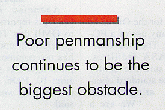



BY CHRISTOPHER J. DOROBEK
GCN STAFF
Years of R&D and just plain tinkering are paying off at the Postal Service.
It now has an optical character reader that can decipher far more hand-addressed mail than the service's existing OCRs.
The Postal Service this month said a software upgrade to OCR systems will boost-- from 2 percent to as high as 30 percent--the amount of hand-addressed mail it processes automatically.
The system will not help with the worst writing--poor penmanship continues to be the biggest obstacle--but it will save USPS time and money by keeping more mail in the automated mail processing stream, officials said.
The service tested the new application in Hartford, Conn., during the busy holiday season. It was able to read 1.3 million addresses that sorters normally would spit out of the automated mail stream for manual processing. That level represented a 22 percent read rate, the Postal Service said.
The goal is to get a bar code on each mail piece, directing it to its destination through the fewest steps possible, said Ed Kueber, the Postal Service's manager of image and telecommunication technology in Merrifield, Va. Of course,the ultimate aim of R&D technicians at the Merrifield research facility is an optical character reader that can read close to 100 percent of hand-addresses mail.
Using clerks to key in addresses costs the Postal Service $25 for every 1,000 letters. Officials said they could not detail the cost of OCR software upgrades. The service plans to add the new software to OCR systems at 254 central processing sites by September.
"It's taken more than 10 years of working with the Postal Service to come to this point," said Sargur Srihari, director of the Center of Excellence for Document Analysis and Recognition (CEDAR) at the State University of New York at Buffalo. CEDAR helped USPS develop the Remote Bar Code System (RBCS) that the service uses to process hand-addressed mail.
To keep letters in the automated mail stream, USPS sends hand-addressed letters through several optical scans. The first level determines whether an address is typed or handwritten, Kuebert said. That first pass identifies about 2 percent of the hand-addressed mail. Typed mail continues through to standard OCR sorters for bar coding. Mail that cannot be read is shunted to RBCS.

The new software cannot resolve the address for bar coding, an image is sent to a clerk who pulls it up on a PC screen and keys in the appropriate address. At this point all mail re-enters the automated sorting process, which relies on the bar codes for sorting mail down to the delivery route.
Kuebert noted that the new software deciphered some hand-addressed mail that the clerks couldn't figure out. Initial versions did slow down postal OCRs, which had been processing 100,000 pieces of mail per hour.
The software, written in C, was developed by CEDAR in Buffalo. Lockheed Martin Corp. designed the RBCS hardware platform, which incorporates a Silicon Graphics Inc. symmetric multiprocessor system and OCRs from EectroCom Automation Imaging Solutions of Fairfax, Va.